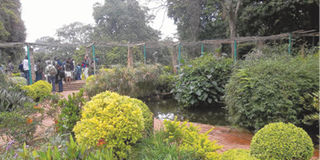The green heart of Nairobi

Nairobi’s City Park.
What you need to know:
- There are spectacular birds to be seen in this world-famous remnant of an ancient forest.
On an overcast grey morning, a silvery-cheeked hornbill lands atop a wizened croton tree. The metre-long bird, which appears smaller from this distance, is joined by four others, to the delight of the bird watchers in Nairobi’s City Park.
With binoculars trained on the birds, Fleur Ng’weno gives the spiel. The silvery-cheeked hornbill is an intra-African migrant that passes through Kenya every year, stopping in Nairobi at its favourite haunts, the City Park and the botanic garden at the National Museums of Kenya.
Its nest has never been found in Kenya though it nests in Tanzania and Mozambique. Thus anyone who sees the nesting site of the silvery-cheeked hornbill in Kenya will earn a feather in their cap.
Fleur’s an amazing narrator to have on any outing with her encyclopedic knowledge and that signature voice that holds everyone’s attention.
Lots of action
There’s a lot of action in the City Park car park. The vervet monkeys are the brats of the place but so cute that you forgive their antics. The Sykes monkeys, on the other hand, are usually shy and keep their distance but at City Park they have become opportunistic, taking whatever food they can.
Black kites sweep through the air while the pied crows hustle and bustle as the silvery-cheeked hornbills hold everyone spellbound. After 10 minutes of watching the hornbills we step into the iconic park that’s older than anyone in the group, having been established in 1923.
It’s truly the green heart of Nairobi with its rich forest and savannah grass plains that is home to more than 120 species of birds, mammals like the giant pouched rat and nine species of bats, including the epauletted fruit bats, insects and reptiles. Spacious green lawns lead to the bandstand that has a history of its own.
Installed in 1929 at the suggestion of the Nairobi Municipal Committee chairman, H R Tate, to entertain visitors, it staged live performances in the 1940s and 1950s, including the brass bands of the King’s African Rifles.
Queen Elizabeth, the Queen Mother of Britain, visited City Park in 1959, followed by the first vice president of India, Sir Sarvepalli Radhakrishnan, respected as a great philosopher, orator and statesman.
I follow the path into the forested glade with towering trees and sounds of the stream flowing through and lose the birdwatchers. I end up by the side of Limuru Road near Parklands. There’s no fence to keep vandals out yet this tiny piece of an ancient forest survives due to the efforts of the Friends of City Park under the umbrella of Nature Kenya.
Rare gem
Badly neglected from the 1980s, this green gem was open to land-grabbers until the Friends of City Park, started in 1996 by concerned citizens to save Nairobi’s green heart, stepped in. I chance upon a tombstone left by the side of the path – very obviously vandalised – which reads ‘In loving memory of Peter Mose Born 1912 Died 3-7-1995. Rest In Peace.’
The open glades of savanna grass are splattered with dashes of wild flowers in bloom. An owl has been spotted in the tree but it’s shy and steals away deeper into the dense foliage. We cross bridges and plains over the canalised Kibagare Stream when Fleur spots the great sparrowhawk suddenly fly by with its catch in the beak.
It lands on a towering tree where the female awaits it. There’s a chick in the nest but at the same time the insufferable safari ants –siafu – are on the wet ground and have everyone hopping around while trying to see this dramatic sighting. The female tears the prey for its chick as the male flies away to search for more
As we hurry off the path, I get my first clear view of the Ruppell’s Robin-chat a few feet from me – I will remember it forever although I’m bad at identifying most species.
“The Ruppell’s Robin-chat likes to feed on the insects that are trying to escape the safari ants,” Fleur’s voice carries through.




